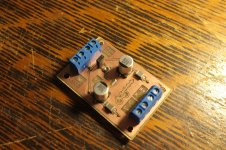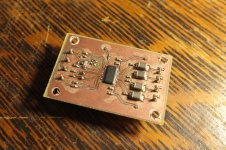So I recently built a class D stereo amp around the TPA3110D2 chip. I was originally going to use it in a simple battery powered stereo application. But then I had a different idea, but I'm not sure how feasible it is.
My question is this:
Would it be possible to build a small, battery powered mono amp with sort of a "subwoofer" channel with this chip? The idea being that one speaker would generate the mid and upper ranges while the second speaker would be dedicated to the lower range. In my mind, I could isolate the mid and upper ranges from the lower with crossovers (either passive or active). Now, I was planning on using pretty small, identical speakers (around 3 inch), which I'm not sure would be that good for the low range. Would this produce deeper bass for this small amp project or would it just be a waste of time?
It should be noted now that, while I have worked on numerous stereo amp projects, I've never used crossovers to isolate signals in any way.
If it is possible, would it make more sense to use active or passive crossovers? In my mind, the difference is that for active, I use the crossover filters before the signals are amplified. For passive, I use the filters on the amp output as it feeds the speakers. The difference being that for the passive scenario, the amps would be amplifying two identical signals.
I guess what I'm stabbing at here is: I want to build a small battery powered amp that has some good bass to it, and I don't mind using a second, dedicated speaker to get it. I imagine there are some flaws to my approach, and I'd much appreciate if anyone can help point them out.
Thanks!
-Chad
My question is this:
Would it be possible to build a small, battery powered mono amp with sort of a "subwoofer" channel with this chip? The idea being that one speaker would generate the mid and upper ranges while the second speaker would be dedicated to the lower range. In my mind, I could isolate the mid and upper ranges from the lower with crossovers (either passive or active). Now, I was planning on using pretty small, identical speakers (around 3 inch), which I'm not sure would be that good for the low range. Would this produce deeper bass for this small amp project or would it just be a waste of time?
It should be noted now that, while I have worked on numerous stereo amp projects, I've never used crossovers to isolate signals in any way.
If it is possible, would it make more sense to use active or passive crossovers? In my mind, the difference is that for active, I use the crossover filters before the signals are amplified. For passive, I use the filters on the amp output as it feeds the speakers. The difference being that for the passive scenario, the amps would be amplifying two identical signals.
I guess what I'm stabbing at here is: I want to build a small battery powered amp that has some good bass to it, and I don't mind using a second, dedicated speaker to get it. I imagine there are some flaws to my approach, and I'd much appreciate if anyone can help point them out.
Thanks!
-Chad
Attachments
There is a nice article here from Rod Elliot about passive vs active crossover:
Active Vs. Passive Crossovers
Hope this helps / Chris
Active Vs. Passive Crossovers
Hope this helps / Chris
Thanks for the post, Chris, interesting article.
So if I'm reading this correctly, to build an active crossover for this project, I just need to build a low-pass filter at the input of the low freq. amp channel and a high-pass filter at the input of the mid/high channel amp. Any input on the most straight forward approach on designing these filters?
Also, do I need to use a larger diameter speaker for the "woofer" channel? For sake of simplicity I was planning on using two small speakers for each channel/range. something on the order of 2.5" - 3" for both. Obviously I've noticed that subwoofers on large stereo systems tend to be built with huge drivers. While I'm not trying to replicate the tremendous bass of one of these systems in this project, I would like it to be able to generate noticeable bass. Am I asking too much of a small speaker?
Thanks again,
-Chad
So if I'm reading this correctly, to build an active crossover for this project, I just need to build a low-pass filter at the input of the low freq. amp channel and a high-pass filter at the input of the mid/high channel amp. Any input on the most straight forward approach on designing these filters?
Also, do I need to use a larger diameter speaker for the "woofer" channel? For sake of simplicity I was planning on using two small speakers for each channel/range. something on the order of 2.5" - 3" for both. Obviously I've noticed that subwoofers on large stereo systems tend to be built with huge drivers. While I'm not trying to replicate the tremendous bass of one of these systems in this project, I would like it to be able to generate noticeable bass. Am I asking too much of a small speaker?
Thanks again,
-Chad
Thanks for the post, Chris, interesting article.
So if I'm reading this correctly, to build an active crossover for this project, I just need to build a low-pass filter at the input of the low freq. amp channel and a high-pass filter at the input of the mid/high channel amp. Any input on the most straight forward approach on designing these filters?
Also, do I need to use a larger diameter speaker for the "woofer" channel? For sake of simplicity I was planning on using two small speakers for each channel/range. something on the order of 2.5" - 3" for both. Obviously I've noticed that subwoofers on large stereo systems tend to be built with huge drivers. While I'm not trying to replicate the tremendous bass of one of these systems in this project, I would like it to be able to generate noticeable bass. Am I asking too much of a small speaker?
Thanks again,
-Chad
Active Filter Design is like a very large forest with many trees,so many that it is easy to get lost. Its a matter of finding the right type to suit your purpose. The purpose is chosen via the drivers and enclosure you intend to use. This last point is so important. you soon find that the drivers and enclosure start designing everything else.
Typically active crossover design is done with op amps. The following website offers a good overview of how this is achieved, and some of the problems that also arise. Active Filters
Also http://www.diyaudio.com/forums/blogs/wintermute/245-synergy-active-crossover.html
Regarding 3 inch drivers the Dayton Wright models offer reasonable throw.... however watch the power level. Isobaric loading may be possible. You need though to look at the whole project, not just that a driver might work. The following articles give great insight into this
The most comprehensive look at small speakers historically has been the LS 3/5a a project commissioned by the BBC see; LS3/5A Library
Cheers / Chris
If your input source is powerful enough to drive headphones, and your amplifier has reasonably high input impedance (which most of them have) then you may not even need opamps at all - you can just make a passive line level crossover, or PLLXO for short. 2nd order is no problem for a simple passive filter, and you hardly ever need higher slopes. Here's a calculator to help you: 2nd order CR filter Design tools
Suggestion: Keep capacitor values below 1uF so the values can easily be found in high quality non-polarized types.
Suggestion: Keep capacitor values below 1uF so the values can easily be found in high quality non-polarized types.
- Status
- This old topic is closed. If you want to reopen this topic, contact a moderator using the "Report Post" button.

